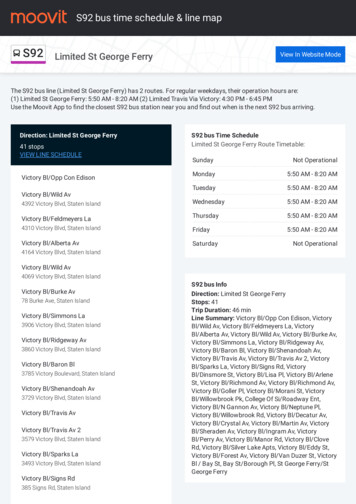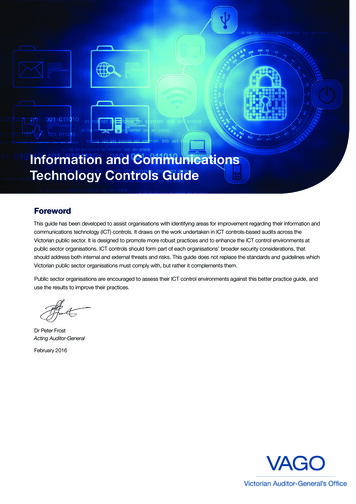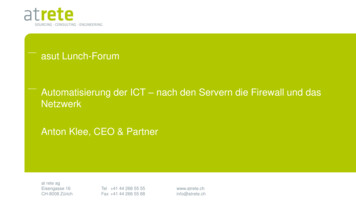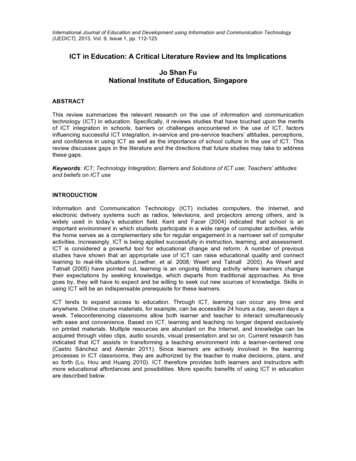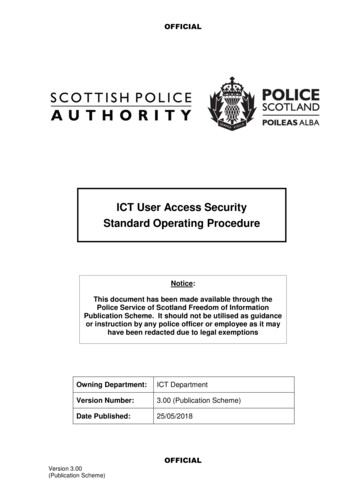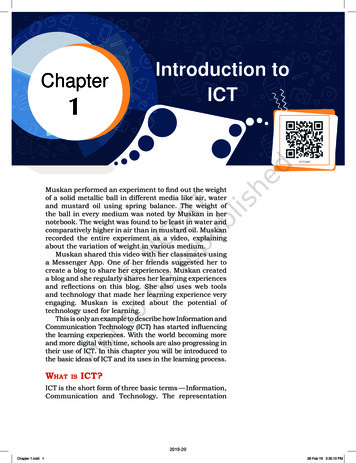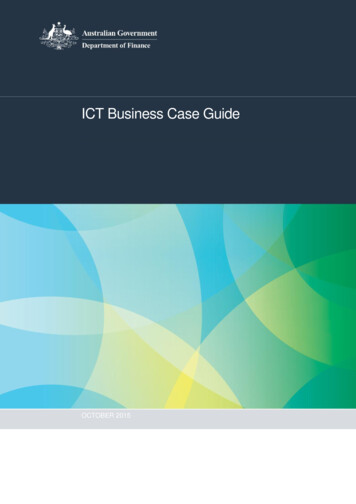
Transcription
ICT Business Case GuideOCTOBER 2015
ContentsICT Business Case Guide1Contents2Introduction3First Pass Business Case51. Executive Summary62. Current Situation73. Proposed Response94. Proposal Summary105. Solution Options116. Option Details137. Implementation Approach168. Work to Second Pass169. Supporting Material18Second Pass Business Case1910. Executive Summary2011. Summary of First Pass Business Case2112. Options Analysis2213. Implementation Approach2414. Supporting Documentation27Attachments28A: Assumptions and Constraints29B: Common ICT Cost Drivers used for the Business Case31C: ICT Cost Estimation Guide35D: Benefits Categorisation44E: Cost Benefit Analysis46F: Common ICT Project Risks50ICT Business Case Guide 2
IntroductionPurpose of this GuideThis guide will assist Australian Public Service entities to develop sound business cases whenseeking to make significant ICT investments. Business cases developed in accordance with thisguide are expected to be suitable for both internal decision making and as inputs to the ICTInvestment Approval process.Further information on the ICT Investment Approval and attachments to this guide are availablefrom the Department of Finance (Finance) website, and relevant Estimates Memorandumsissued to entity Chief Financial Officers.Purpose of a Business CaseThe primary aim of a business case is to provide information on the benefits, costs and risksinvolved with a proposal. It forms the basis for effective decision makingA business case captures the reasoning for initiating an investment. Whenever resources areconsumed, they should be in support of a specific business need. A compelling business caseadequately captures both the business need and how the proposed investment meets that need.The business case provides a basis for planning and implementation. It provides the justificationfor the investment, so the ongoing viability of the investment should be measured against thebusiness case.Business cases are evaluated to ensure: the investment has value, importance and relevance the implementation will be properly managed the organisation has the capability to deliver the benefits the organisation’s resources are working on the highest value opportunities initiatives with inter-dependencies are undertaken in the optimum sequenceICT Investment Approval ProcessUnder the ICT Investment Approval process, entities prepare an initial business case to beconsidered as part of government’s budget deliberations for that year.The government considers whether it agrees with the proposal in principle and whether toprovide funding towards a more detailed business case. Where the government approves aninitial business case, the sponsoring entity then prepares a detailed business case. When it hascompleted the detailed business case, the sponsoring entity provides a submission for secondpass review.First Pass Business CaseThe First Pass Business Case supports the sponsoring Minister’s Cabinet submission seekingfirst pass approval for a proposal.3
The purpose of an ICT First Pass Business Case is two-fold. First and foremost, it providessufficient level of information on the benefits, costs and risks of a proposal for Cabinet to makean informed decision on the Government’s ICT investment. Entities should take advantage of theICT First Pass Business Case as an avenue to demonstrate, with rigor, clear business needs,sound policy development and well-considered enabling ICT investment.The First Pass Business Case puts in place a mechanism that improves planning and reviewprocesses in an effort to reduce the risks associated with major ICT-enabled proposals andprovide the Government the opportunity to consider whether the proposal meets its policy andservice delivery objectives.Second Pass Business CaseThe Second Pass Business Case supports the sponsoring Minister’s Cabinet submission seekingsecond pass approval for a proposal. An effective Second Pass Business Case will provideassurance that the planning, consideration and consultation required to improve the chance ofsuccessful delivery has been undertaken.A Second Pass Business Case builds more detail into the cost assessments and risk mitigationstrategies developed for those options agreed in principle by the government at the first pass.The revised cost estimates require rigorous planning of the scale and features of the ICTinfrastructure, applications and support required for each option. The analysis will includequality estimates from the private sector where appropriate.Accordingly, the information (data, plans, and specifications) must be of sufficient detail notonly to inform Cabinet’s decision, but also to act as the basis for the implementation of theproposal.Specific information about the Budget process and timeframes is available to governmentofficials from their Chief Finance Officer (CFO) unit. Further information about this document isavailable by emailing ictadvice@finance.gov.au.ICT Business Case Guide 4
First Pass Business Case
First PassBusiness CaseAt a glance: Your First Pass Business Case provides Cabinet with its firstopportunity to consider whether to use ICT to meet its policy andservice delivery objectives. The business case should convey to Cabinet a range of practical,indicative ICT options, together with any non-ICT solutions thatmay be available, including the likely costs, benefits and risksassociated with each one. Your business case should present an objective appraisal of therelative strengths and weaknesses of each ICT option (not advocatefor a single, preferred solution).The following section of the guide steps through the structure of a First Pass Business Case.1. Executive Summary1.1Summary of OptionsUse the executive summary to provide a brief description of the current situation and theproposed response. Provide a summary of the options including initial cost estimates and thestrengths and weaknesses of each option. Consider using a table format similar to the onebelow:Figure 1: Summary of OptionsOption One: Option NameBrief Description: Include a one line description of the option.Total Cost: XXMOption Lifespan: N yearsWeaknessesRecommendationStrengthsOption N: Option NameBrief Description: Include a one line description of the option.Total Cost: XXMOption Lifespan: N yearsWeaknessesRecommendationStrengthsThe recommendations must be consistent with the recommendations in the Portfolio BudgetSubmission to Cabinet.ICT Business Case Guide 6
First PassBusiness CaseFigure 2: Financial SummaryYear One(000)Option OneCapitalNPV: XXmOperationalYear Two(000)YearThree(000)Year Four(000)Total(000)TotalOption TwoCapitalNPV: XXmOperationalTotalOption ThreeCapitalNPV: XXmOperationalTotalOption nCapitalNPV: XXmOperationalTotal2. Current SituationThis section sets out the problem that the Proposal is responding to, or the opportunity. Also,use graphs, reference material, images to tell the story of the current situation.2.1Policy/ Entity ContextState the business objective that options for a new ICT-enabled investment would help toachieve. Compare the proposed investment with your entity’s strategic priorities. Refer directlyto the outcomes and outputs in your entity’s Budget Statements, corporate plan and annualreport. Include identification of any relevant entity risks that contribute to the triggeringsituation for the proposal.ICT Business Case Guide 7
First PassBusiness CaseThe entity context section compares the proposed investment with your entity’s strategicpriorities. It should explain how the ICT investment could assist your entity to deliver itsoutputs and outcomes more effectively and efficiently1. The section must refer directly to theoutputs and outcomes in your entity’s Portfolio Budget Statements, corporate plan and annualreport.2.2Current Technical EnvironmentFor ICT enabled business cases, describe the current situation not only from a businessperspective – but also from a current technical perspective. The Technical Environment sectionshould document relevant components of your current ICT baseline. For example, the sectionshould briefly describe: ICT infrastructure (both hardware and software) Voice and data communications facilities Workforce skills and numbers SecurityThe section must describe any gaps that the project must address to meet the Statement ofSuccess and performance indicators. Gaps may be specific elements or more general servicelevels related to current levels of interoperability, security and efficiency.The purpose of this step is to clarify your ICT environment as it stands and any shortfalls. It isnot useful to revisit past developments and events at this point. High level environment andarchitecture diagrams can be helpful, but keep in mind the audience for the document whenthinking about the degree of technical detail to include.2.3Business ProblemYour business case should begin by stating the practical business problem that options for anew ICT capability could help to overcome in achieving the government’s policy and servicedelivery objectives.An ICT investment may address several business problems, including: Supporting stakeholder priorities and business needs Enhancing the level of service delivered to stakeholders Reducing entity and whole-of-government costs Overcoming the limitation and constraints of a current solution2.4Stakeholder ImpactDescribe the impact of the current situation on stakeholders.Effectiveness. In accounting terms, the extent to which an entity achieved the objectives established for its operations or activities, whether those objectives were expressedin terms of outputs or outcomes (AAS 29). In outcome framework terms, the extents to which outputs and / or administered items make positive contributions to the specifiedoutcome. Effectiveness indicators are used to assess the degree of success in achieving outcomes.Efficiency. The extent to which the entity maximised the outputs produced from a given set of inputs or minimised the input cost of producing a given level and quality ofoutputs (AAS 29).1ICT Business Case Guide 8
First PassBusiness Case2.5Current RisksDescribe the risks that the current situation creates, and the risks of not responding to thecurrent situation. Include both business and technical risks.3. Proposed ResponseHaving identified the “Why” of the business case, the Proposed Response starts to articulate the“What” is being proposed to be done in response.This is about identifying the desired end state or destination, rather than the detail of “How” toget there.Include a description of the proposed response, including any evidence that this will be aneffective response to the current situation. This section should focus on ‘what’ is being proposedas a response, rather than ‘how’ that response can be delivered.3.1Strategic AlignmentIdentify how the proposed response aligns with your entity objectives listed in the policy/entitycontext section. Refer to your entity’s Portfolio Budget Statements to identify the outcomes thatdelivery of this response would support.Identify how the proposed response aligns with whole-of-government (WofG) policies,priorities and approaches.Where relevant provide specific reference to: ICT Customisation and Bespoke Development PolicyICT Skills PolicyAustralian Government ArchitectureCyber Security PolicyCloud Computing StrategyOpen Source Software PolicyWofG Common Operating EnvironmentEnvironmental Sustainability of ICTGov 2.0Coordinated procurementData Centre StrategyDigital Service Standard (Digital Transformation Office)Information on these can be found on the Finance and Digital Transformation Office websites.It is recommended that entities consider the Digital Service Standard and contact the DigitalTransformation Office as soon as practical when developing a proposal.The technical environment and business environment sections that follow should describe thevision of the future state of the organisation. What will be different about the current situationICT Business Case Guide 9
First PassBusiness Casefrom both a technical and business perspective as a result of the proposed response (not thespecific options for delivering that response)?Figure 3: Strategic AlignmentSource3.2Stated StrategyTechnical EnvironmentDescribe the future state of the technical environment based on the proposed response (not thespecific options). High level environment and architecture diagrams can be helpful, but keep inmind the audience for the document when thinking about the degree of technical detail toinclude.3.3Business EnvironmentDescribe the future state of the business operational environment based on the proposedresponse.3.4BenefitsProvide a statement of the benefits that the project will achieve and indicative timing for whenthey will be realised. Include information on how benefits will be measured and the expectedtargets to be achieved for each measure.Include interim and longer term benefits, and include any identified disadvantages.4. Proposal SummaryThe information provided about the current situation, the proposed intervention and theexpected benefits may usefully be summarised in an Investment Logic Map, or similar high levelvisual representation.ICT Business Case Guide 10
First PassBusiness Case5. Solution Options5.1Design CriteriaInclude where possible the high level requirements that any viable solution will be expected todeliver against. These will be examined in greater detail in Second Pass.Note high-level business requirements that the design must address – for example, considerareas such as: functionality;security and privacy;performance;reliability, availability and maintainability;policy, strategic, standards and architectural compliance requirements (such as theAustralian Government Architecture);usability, flexibility, scalability, interoperability; andmajor external interfaces and interdependencies.These requirements provide the criteria for comparing options. Indications of relative value willbe informative.5.2Identified OptionsThe business case must consider a range of options ranging from minimal technology upgradesto more innovative ICT business solutions, including those that may challenge prevailing interentity ICT planning and service delivery habits. This ensures that all options are consideredobjectively on their merits. The outcome will be a shortlist of options for analysis andcomparison in the initial cost-benefit analysis. Normally this shortlist will include a Base case(maintaining existing arrangements), a Do Minimum case (to address only urgent andunavoidable requirements) and two to three other options.Identify the practical options for achieving the objectives of the initiative. Also, identifydiscarded options and the reasons.In the First Pass Business Case, options are high-level, covering practical ways of delivering therequired outcomes. Examples of the appropriate level are: outsourced against in-house service delivery; major ICT development against increased staffing levels; and centralised against regional service delivery.If after you have completed your options analysis you decide that there is only one option that ispractical or preferred, you should explain why each of the other options are not feasible, or notpreferred, keeping in mind that a case must always offer the decision maker appropriatediscretion.A business case for a significant ICT project with only one practical option would be exceptionaland require detailed justification.ICT Business Case Guide 11
First PassBusiness CaseFigure 4: OptionsOption 1 – Base Case – Do esses5.3Options AnalysisSummarise the most significant features of each option. A preliminary analysis of the NetPresent Value (NPV) of the proposal should be included. The NPV analysis should summarisethe value flows associated with key costs and benefits, discounted to a present value using anappropriate discount rate. Present a tabular comparison of the options against costs, designrequirements listed above and risk. Note any preferences in a “Conclusions” line.For example:Figure 5: Options AnalysisRequirementsOption 1Option 2Option 32nd RankingOptionPreferredOption3rd RankingOptionOption 4BenefitsTotal Costs(Over n Years)NPV: XXmImplementationCostsOngoing CostsImplementationTimeframeRequirement 1Requirement 2Requirement 3ImplementationRiskConclusion(e.g.)ICT Business Case Guide 12
First PassBusiness Case6. Option DetailsRepeat this section of the business case for each option, including the following sub-sections: DescriptionStakeholder ImpactCostBenefitCost-Benefit AnalysisRiskScheduleThe details for each option are included as attachments to the First Pass Business Case.The detail provided should focus on differentiating the options. Provide enough detail for eachoption to: 6.1support comparative analysis; andsupport feasibility and assumptions.Option One Details6.1.1 DescriptionProvide a description of the option.6.1.2 Stakeholder ImpactProvide an assessment of the stakeholder impact, both positive and negative should this optionbe implemented.6.1.3 CostICT-related costs are expense and capital costs, including infrastructure, software,administration, maintenance and resourcing costs associated with the business transformationdelivered by ICT enabled projects – including processes associated with the planning, design,development, change management, training and evaluation of the project.To provide a common basis for planning, First and Second Pass Business Cases must apply thefollowing definitions of ICT capital and operating costs: Capital costs – directly related to the creation of one or more assets (including relevantworkforce costs).Operating costs – indirectly related to the implementation of the option and with no directconnection to the creation of an asset.ICT Business Case Guide 13
First PassBusiness CaseDescribe the cost associated with any high-level business process transformation required bythe option. Include: identification of new or changed organisational units;identification of new or changed business processes;estimates of the changes in staffing levels; anddescription of the approach to organisational change, including recruitment and training.Identify the costs for major ICT components required to support the option. For each ICTcomponent include:ICT development information: description of each ICT element; architectural and standards compliance; and identification of the service levels required.ICT BAU operations and support information: description of the concept for operating and supporting the ICT element; and estimates of the ICT operation and support costs (i.e. BAU costs).Identify and describe the approach to implementing any other systems that relate to the option(for example, buildings and media campaigns). Highlight the interdependencies between thestreams of work (e.g. entity delivery of an advertising campaign by internet may have ICTimplications).Committed estimates involving a point estimate (of say ‘ 50 million’) plus or minus X% arerequired, providing government with clear advice on the likely cost of the ICT option, taking intoaccount the potential impact of the worst-case scenario. You should also provide the logic thatunderpins the point estimate and worst-case components.At first pass, the cost estimates for each option should include a significant contingencyallocation, particularly for options (or elements of options) with medium-to-high technologyrisks. For such options, a contingency allocation of at least 30% would be appropriate.You should build your contingency allocation by establishing the risk and corresponding dollarfigure for each element (such as software development or customisation), after mitigationstrategies have been considered.Further guidance on cost estimation is provided at Attachment C.6.1.4 BenefitsIdentify the benefits expected to be delivered by each option, the timeframe expected forrealisation of each benefit, how each benefit will be measured, and the broad targets for eachmeasure.Further guidance on benefits is provided at Attachment D, and the Performance IndicatorCatalogue on the Finance website.ICT Business Case Guide 14
First PassBusiness Case6.1.5 Cost-Benefit AnalysisAt first pass you are expected to provide an initial cost-benefit analysis for each of the options inyour ICT business case. Focus on the benefits of each option from the perspective of end-usersand of your entity. As part of your cost-benefit analysis, you should consider each option interms of the inputs of cost, volume and time. You should also conduct a basic sensitivityanalysis.The cost-benefit analysis culminates in an overall economic assessment for each option and acomparison of the relative value of each option. This assessment is based on the net presentvalue (NPV) method where appropriate. At first pass, you are not expected to provide adefinitive NPV calculation. However, in order to submit a convincing First Pass Business Case,you are required to provide an initial NPV calculation for each option, and an initial comparisonbetween the options even though the basis for the cost and benefit information may only bepreliminary.Further guidance on Cost-Benefit Analysis is provided at Attachment E.6.1.6 RiskFor each option, provide a high-level risk assessment that gives an overall risk rating andidentifies the main risks and treatments. Examples of high-level risks include: industry maturity;complexity; andexternal interactions and interdependencies.6.1.7ScheduleProvide a broad schedule linking the major cost elements, and showing the significant externalinfluences, listing any known internal or external milestones affecting or constraining anyschedule.You should indicate how long each option is likely to take to be fully operational and deliver theplanned benefits. It is important to be realistic in your planning and to explain the logic andassumptions that underpin each element of your schedule. For example, to allow sufficient timefor software development, test and evaluation, and user training and acceptance, you shouldlook to similar work performed elsewhere in your entity or in another entity recently. Youshould use this knowledge to question informal schedule advice from potential industrypartners.6.2Option Two DetailsFollow the same format as Option One Details for each option.ICT Business Case Guide 15
First PassBusiness Case7. Implementation ApproachHaving identified the problem to be solved and the options to be explored in response, thissection of the business case is about confirming the Entity’s capability and capacity to deliverthe preferred solution.Describe the implementation approach for delivering the investment, including theproject/programme management governance structures and other key control and assuranceprocesses, describing variations for each identified option if different.If a governance structure is not yet in place, identify the management issues that will need to beaddressed, including consideration of: the existing internal organisation;stakeholder engagement;consultation processes; andapproval processes.8. Work to Second PassEntities should provide an accurate costing, risk assessment and schedule for the work neededto develop a rigorous business case for second pass, including any joint planning, prototypework or studies that should be conducted with industry.Identify funding required to develop the Second Pass Business Case. Substantiate any fundingrequest with a breakdown of the work elements required.The work-to-second-pass section distinguishes between items that could be funded by yourentity, and those for which you are seeking extra funds (such as technical feasibility studies, andprototype development, testing and demonstrations by industry).A table outlining the costs to second pass, similar to Figure 7, can be included.ICT Business Case Guide 16
First PassBusiness CaseFigure 6: Costs to Second PassPhase OneCompletion Month YearItemIndicative Cost ( 000)Project ManagerFinancial ModellerBusiness AnalystTechnical Writer/Project AdminArchitects (Solution & Data)DevelopersBusiness UsersSMEsMarket ApproachPhase One TotalPhase TwoCompletion Month YearItemIndicative Cost ( 000)Project ManagerBusiness AnalystTechnical Writer/Project AdminBusiness User InvolvementVendor/SMEsHardware (Test/Develop Environ.)Hardware Maintenance and SupportPhase Two TotalWork to Second Pass TotalICT Business Case Guide 17
First PassBusiness Case9. Supporting MaterialThe following is a list of supporting material that should be addressed at a high level at firstpass. This content may be included either within the business case or as an attached document. Benefits Management PlanSolution (Architecture) DesignRequirements SpecificationSecurity PlanProcurement StrategyICT Business Case Guide 18
Second Pass Business Case
Second PassBusiness CaseAt a glance: The steps for a Second Pass Business Case are the same as for thefirst pass, but require greater rigour and assurance, particularlyin the areas of cost, benefits, risk and schedule. Analysis during the second pass stage will include measures suchas proof-of-concept tests and formal market approaches to providegreater precision and confidence in estimates. The analysis concentrates on those options selected by thegovernment for second pass treatment. The procurement plan must show how each ICT option could beacquired and delivered gradually at lowest risk. The governance plan should explain how progress will be monitoredand measured in your organisation, how any emerging risks will beaddressed, and when regular progress reports will be provided tothe government.The following section of the guide steps through the structure of a Second Pass Business Case.10. Executive SummaryA key consideration in the development of the Second Pass Business Case is the question ofcomplexity. Several factors contribute to the complexity of a proposal, the degree of changeproposed, the number of required components in the proposed solution, the range of crossentity and cross government interaction required, the dollar value, technical complexity andnovelty and so on.In determining the complexity of a proposal – and therefore the range and level of detail ofinformation required in the business case, keep in mind that the business case needs to provideinformation sufficient for the decision being sought.10.1 RecommendationsThe recommendations must be consistent with the recommendations in the Cabinet submissionas detailed in Cabinet Circular No.1 each year, available from your entity Cabinet Liaison Officer.ICT Business Case Guide 20
Second PassBusiness Case11. Summary of First Pass Business CaseMuch of the material that makes up the background for the Second Pass Business Case may bedrawn from the First Pass Business Case. As is the case all through the Second Pass BusinessCase, entities should provide additional, more detailed or updated information.11.1 Policy ContextState the business objective that options for a new ICT-enabled investment would help toachieve. Compare the proposed investment with your entity’s strategic priorities. Refer directlyto the outcomes and outputs in your entity’s Budget Statements, corporate plan and annualreport.11.2 Business ProblemBriefly reiterate the business problem the proposal addresses in the context of the entity’s rolesand responsibilities. Note any factors that are critical to achieving the objectives (CriticalSuccess Factors – CSFs).11.2.1 Proposed ResponseInclude a description of the proposed response, including any evidence that this will be aneffective response to the current situation. This section should focus on ‘what’ is being proposedas a response, rather than ‘how’ that response can be delivered. Consider using visualrepresentations of Blueprints, Visions or Strategic Intention for the proposal where possible.11.3 Outcome of First PassProvide a statement of the outcome of the first pass Cabinet endorsement, including: selection of options for second pass review;caveats;deviations from initial proposals; andadditional functions required.11.4 Changes since First PassProvide a brief summary of key developments in the organisation, policy space or broadergovernment context since the approval of First Pass, as well as providing an overview of thework undertaken to produce this Second Pass Case.Describe any significant changes that have occurred since endorsement of the first passproposal that will affect the information (type, detail, availability, applicability) the sponsoringentity is providing for second pass.ICT Business Case Guide 21
Second PassBusiness CaseExamples include (but are not limited to) changes to: external environment;Government policy and/or regulatory requirements;Governance profile;ICT elements;security risks;ongoing support model;procurement plans;identified risks and risk treatment; andcustomer/client base.Mention any significant deviation from the planned work to second pass identified in the FirstPass Business Case.12. Options AnalysisThe Options Analysis section is one where additional information may be required based on therelative complexity of the proposal. Consider adding more detailed information about costdrivers, costing approaches and include a more detailed description of the costing model.Consideration may also be given to third party verification of the costing model and anyassumptions made during the development of the costing.A definitive analysis of the Net Present Value (NPV) of the proposal should be included. The NPVanalysis should summarise the value flows associated with key costs and benefits, discounted toa present value using an appropriate discount rate. Refer to Attachment E: Cost-BenefitAnalysis.Where more than one option is bein
ICT Business Case Guide 2 Contents ICT Business Case Guide 1 Contents 2 Introduction 3 First Pass Business Case 5 1. Executive Summary 6 2. Current Situation 7 3. Proposed Response 9 4. Proposal Summary 10 5. Solution Options 11 6. Option Details 13 7. Implementation Approa

